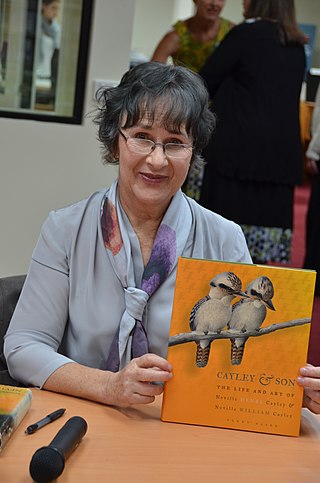Gregory Macalister Mathews CBE FRSE FZS FLS was an Australian-born amateur ornithologist who spent most of his later life in England.

The Royal Australasian Ornithologists Union (RAOU), now part of BirdLife Australia, was Australia's largest non-government, non-profit, bird conservation organisation. It was founded in 1901 to promote the study and conservation of the native bird species of Australia and adjacent regions, making it Australia's oldest national birding association. In 1996, the organisation adopted the trading name of Birds Australia for most public purposes, while retaining its original name for legal purposes and as the publisher of its journal, the Emu. In 2012, the RAOU merged with Bird Observation & Conservation Australia to form BirdLife Australia.

The regent parrot or rock pebbler is a bird found in southern Australia. It has predominantly yellow plumage with a green tail. The bird is found primarily in eucalyptus groves and other wooded areas of subtropical southwestern Australia, as well as in a smaller area of subtropical and temperate southeastern Australia. Seeds make up the bulk of its diet.
Dominic Louis Serventy was a Perth -based Western Australian ornithologist. He was president of the Royal Australasian Ornithologists Union (RAOU) 1947–1949. He assisted with the initial organisation of the British Museum's series of Harold Hall Australian ornithological collecting expeditions during the 1960s, also participating in the third (1965) expedition.
Lesley Brooker is an Australian ornithologist based in Western Australia following retirement from a career with the CSIRO's Division of Wildlife Research. There she worked, as a database manager and computer modeller, on developing methodologies for the re-design and restoration of agricultural lands for bird conservation. Since then, she has collaborated with her husband Michael Brooker in studies on cuckoo evolution, population ecology of fairy-wrens and spatial dynamics of birds in fragmented landscapes.
John Casimir Zichy Woinarski is an Australian ornithologist, mammalogist, and herpetologist. He was awarded the 2001 Eureka Prize for Biodiversity Research. In the same year he was the recipient of the D. L. Serventy Medal, awarded by the Royal Australasian Ornithologists Union for outstanding published work on birds in the Australasian region.
Ian Cecil Robert Rowley was an Australian ornithologist of Scottish origin. He was born in Edinburgh and educated at Wellington College and Cambridge University. Following service in the Royal Navy during the second world war, he moved to Australia in 1949 and graduated in Agricultural Science from the University of Melbourne under the Commonwealth Reconstruction Training Scheme.

Penelope Diane Olsen is an Australian ornithologist and author.
James Allen Keast was an Australian ornithologist, and Professor of Biology at Queen's University, Kingston, Ontario, Canada. Born in Turramurra, New South Wales, he performed war service 1941–1945 in New Guinea and New Britain. He earned his BSc (1950) and MSc (1952) degrees at the University of Sydney, going on to earn an MA (1954) and PhD (1955) from Harvard. He started the first natural history series on Australian television in 1958–1960. A long-time member and benefactor of the Royal Australasian Ornithologists Union (RAOU), he was elected a Fellow of the RAOU in 1960. Keast joined the faculty of Queen's in 1962, and in 1989 became a professor emeritus. In 1995 he was awarded the D.L. Serventy Medal for outstanding published work on birds in the Australasian region. As well as numerous scientific papers, he authored and edited several books.
John Warham was an Australian and New Zealand photographer and ornithologist notable for his research on seabirds, especially petrels.
Professor Jiro Kikkawa was a Japanese Australian ornithologist. His early zoological studies were at Tokyo University, Japan and at Oxford University in England. He subsequently spent three years at the University of Otago in New Zealand where he began what was to become an enduring focus of research, the behavioural ecology of Silvereyes and other species of Zosterops.
Dr Hugh Alastair Ford is an Australian ornithologist.

Hubert Massey Whittell OBE was a British army officer, and later an Australian farmer and ornithologist who compiled a history and bibliography of ornithology in Australia from its origins until the mid-20th century.

The Birds of Western Australia is a book first published in 1948 by Patersons Press Ltd in Perth, Western Australia. Its full title was originally A Handbook of the Birds of Western Australia (with the exception of the Kimberley Division), though with the publication of the 5th edition only the shorter form was used. It was authored by Dominic Serventy and Hubert Whittell. It was issued in octavo format (228 x 148 mm) and contains 372 pages bound in blue buckram with a dustjacket illustrated with a painting of Australian pelicans by Harley Webster. It contains a coloured frontispiece of paintings of the heads of Meliphaga honeyeaters, with numerous black-and-white drawings and maps scattered through the text. The second edition (1951) contained colour plates by Olive Seymour.

A Field Guide to Australian Birds is a two-volume bird field guide published by Rigby of Adelaide, South Australia, in its Rigby Field Guide series. The first volume was issued in 1970, with the second volume appearing in 1974. It was Australia’s first new national bird field guide since the 1931 publication of the first edition of Neville Cayley’s What Bird is That?. It was principally authored by Australian ornithologist, artist and photographer Peter Slater.
James David Macdonald FLS FZS FIB was a Scottish-Australian ornithologist and ornithological writer. A traditional museum ornithologist, he did much to build up the collections of African and Australian birds held by the British Museum, as well as popularising ornithology through his writings.

The Harold Hall Australian expeditions comprise a series of five main ornithological collecting expeditions carried out in the 1960s and covering much of the Australian continent.

The Slater Field Guide to Australian Birds is one of the main national bird field guides used by Australian birders.
Peter Slater was an Australian ornithologist, wildlife artist and photographer.

Frederick Bulstrode Lawson Whitlock (1860-1953) was an ornithological writer and oölogist, active in England and across Western Australia.









